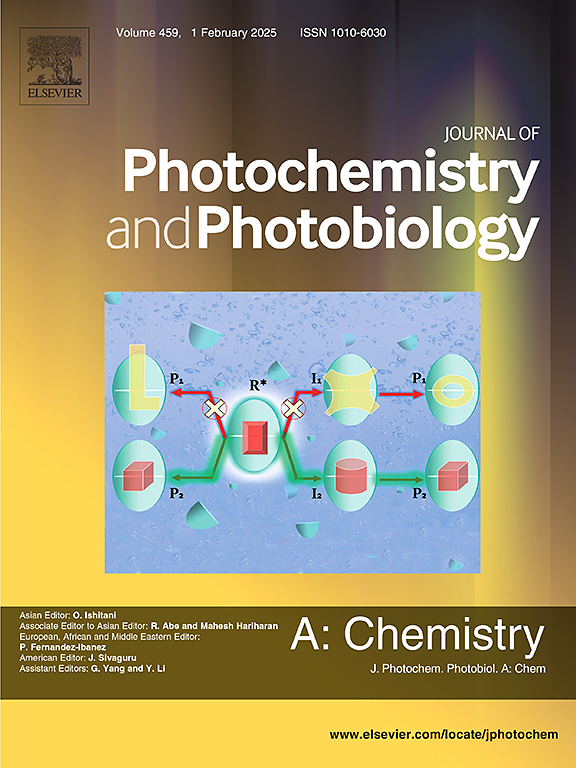Exploring defect induced fluorescence in borophene dots
IF 4.1
3区 化学
Q2 CHEMISTRY, PHYSICAL
Journal of Photochemistry and Photobiology A-chemistry
Pub Date : 2025-03-21
DOI:10.1016/j.jphotochem.2025.116399
引用次数: 0
Abstract
Borophene dots are emerging as promising zero-dimensional nanomaterials due to their unique structural, electronic, and photophysical properties, particularly their defect-induced fluorescence. This study introduces a novel, scalable synthesis for obtaining fluorescent borophene dots by thermal degradation of sodium borohydride in air. The borophene processing involves controlled heating and intermediate cooling cycles. This route enables incorporating oxygen-related defects as active sites for fluorescence under ambient conditions. Comprehensive characterization techniques, including TEM, AFM, XPS, FTIR, and photoluminescence spectroscopy, reveal that the interplay between boron-hydride and oxygen functional groups modulates the photophysical properties of borophene dots. The findings demonstrate that oxygen-related defects enhance light absorption and emission, with photoluminescence arising from defect-mediated radiative transitions. Defect engineering plays a primary role in tailoring the optical properties of borophene dots, which can be used in optoelectronics, sensing, and bioimaging.

探索硼罗芬点缺陷诱导荧光
硼罗芬点由于其独特的结构、电子和光物理性质,特别是其缺陷诱导的荧光,正成为一种有前途的零维纳米材料。本研究介绍了一种新的、可扩展的合成方法,通过在空气中热降解硼氢化钠来获得荧光硼罗芬点。硼苯的加工包括控制加热和中间冷却循环。这条路线能够在环境条件下将氧相关缺陷作为荧光的活性位点。通过TEM、AFM、XPS、FTIR和光致发光光谱等综合表征技术,揭示了氢化硼和氧官能团之间的相互作用调节了硼苯点的光物理性质。研究结果表明,氧相关缺陷增强了光的吸收和发射,并通过缺陷介导的辐射跃迁产生光致发光。缺陷工程在调整硼罗芬点的光学特性方面起着主要作用,硼罗芬点可用于光电子学,传感和生物成像。
本文章由计算机程序翻译,如有差异,请以英文原文为准。
求助全文
约1分钟内获得全文
求助全文
来源期刊
CiteScore
7.90
自引率
7.00%
发文量
580
审稿时长
48 days
期刊介绍:
JPPA publishes the results of fundamental studies on all aspects of chemical phenomena induced by interactions between light and molecules/matter of all kinds.
All systems capable of being described at the molecular or integrated multimolecular level are appropriate for the journal. This includes all molecular chemical species as well as biomolecular, supramolecular, polymer and other macromolecular systems, as well as solid state photochemistry. In addition, the journal publishes studies of semiconductor and other photoactive organic and inorganic materials, photocatalysis (organic, inorganic, supramolecular and superconductor).
The scope includes condensed and gas phase photochemistry, as well as synchrotron radiation chemistry. A broad range of processes and techniques in photochemistry are covered such as light induced energy, electron and proton transfer; nonlinear photochemical behavior; mechanistic investigation of photochemical reactions and identification of the products of photochemical reactions; quantum yield determinations and measurements of rate constants for primary and secondary photochemical processes; steady-state and time-resolved emission, ultrafast spectroscopic methods, single molecule spectroscopy, time resolved X-ray diffraction, luminescence microscopy, and scattering spectroscopy applied to photochemistry. Papers in emerging and applied areas such as luminescent sensors, electroluminescence, solar energy conversion, atmospheric photochemistry, environmental remediation, and related photocatalytic chemistry are also welcome.

 求助内容:
求助内容: 应助结果提醒方式:
应助结果提醒方式:


